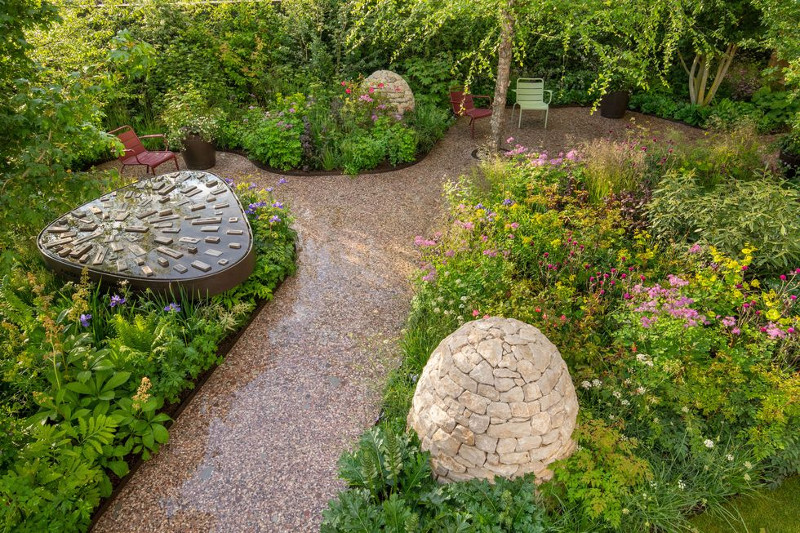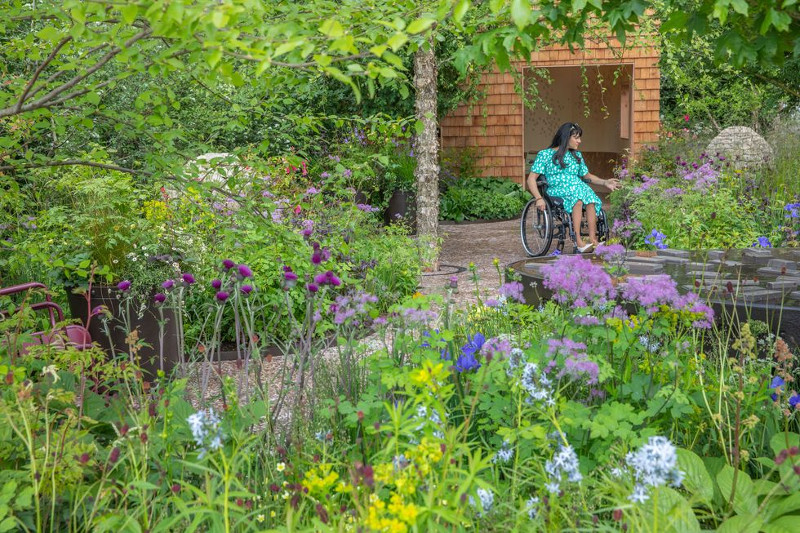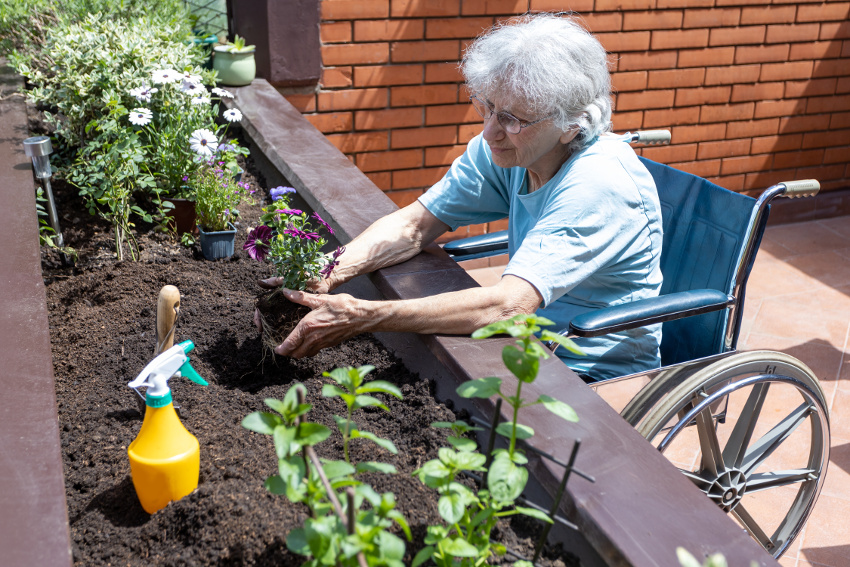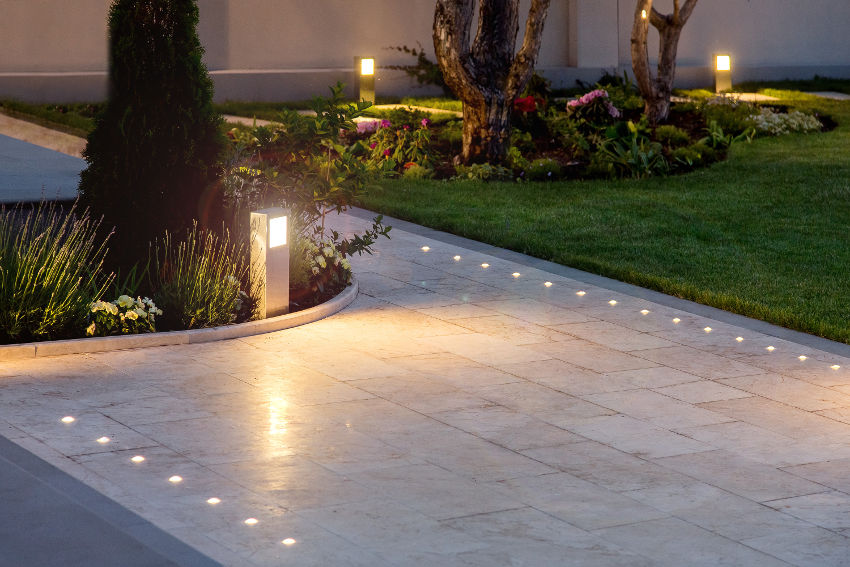Gardens play such an important part in our lives. They give us the means to extend our living space and offer a place to relax and improve our health and well-being. With such a critical role, it’s important everyone can access and enjoy them.
Creating an accessible garden allows anyone, no matter their age or physical limitations, to experience the therapeutic benefits of gardening without feeling limited by mobility or disability.
- They feel encouraged to get outside more often to spend quality time in the garden.
- Their confidence and self-esteem is maintained knowing it’s still possible to carry out gardening activities with some simple modifications and adaptations.
- Hand-eye coordination, strength and balance is improved through the physical motions used to do tasks like weeding, pruning, watering or planting
- They gain a sense of achievement and accomplishment through being able to independently do gardening tasks.
- An escape is provided from the stresses of coping with illness or disability.
- Experimenting with new garden ideas provides continual stimulation and learning.
With so many benefits attached to gardening, we thought we’d share a few tips on how to achieve a welcoming and accessible outdoor space.
8 ideas for creating an accessible garden
Designing and building an accessible garden calls for equal measures of ingenuity and understanding. Careful consideration is required at every stage to make sure the result is comfortable to use, easy to maintain and simple to navigate.
Just as importantly it shouldn’t feel like it’s designed purely for accessibility. But is a balance between beauty and functionality.
1. Get to know the gardener
Perhaps the most critical first step is to understand what’s needed from the garden. A wheelchair user, for example, will have a completely different set of needs from someone who is blind or partially sighted. Find out how they want to use the garden, what they like to do, the range of movements they can comfortably make, and any adjustments needed to accommodate mobility equipment.
For example, providing table or manger style planters which allow a wheelchair user to get their knees under the table and work closer to the plants, may be more comfortable to use than a raised bed with flat sides. Adding a recess in the table will make it even easier to reach things.
Spending time really getting to know these details first helps inform the choices you then make to create a landscape that aids using the garden.
2. Build easy to navigate paths
Having easy to navigate paths is key to helping people move easily and safely from one area to another.
They need to be wide enough to accommodate a wheelchair, a walking frame or a carer helping someone round the garden.
As a guide:
- A width of 2m provides room for 2 wheelchairs, or two people, side by side.
- A width of 1.5m is enough room for 1 wheelchair plus pedestrian alongside.
- A width of 1.0m gives room for 1 wheelchair with no room alongside.
They should be planned so that someone can easily circulate around the garden to all the areas they want to reach. Think gentle curving paths rather than ones with angular, sharp corners. They should also have areas that are wide enough to allow someone to change direction comfortably.
A flat, smooth, stable, anti-glare, non-slip surface is essential to avoiding potential hazards and difficult to navigate sections. Using something like low maintenance resin bonded gravel is a good choice, as are large format paving slabs – so long as they are laid level and provide a non-slip surface.
Avoid using loose materials such as soft bark, gravel and chippings, cobbles and uneven sets.
If a garden user is blind or partially sighted, something else to consider is using a variety of paving textures to delineate between different areas. Or to signal a change in direction of the path. You should also try to keep paths as straight as possible, with handrails on sections where there is a change in level.
3. Allow for regular rest stops
Building in points along the path where people can stop and rest are not only useful but also allow for someone to pause and appreciate their garden.
Add chairs and benches at well placed intervals. If the gardener is a wheelchair user, then make sure seating areas can also comfortably accommodate their chair.
A lovely idea for an accessible garden is to consider building integrated seating into raised beds. That way the wonderful sights, sounds and smells of the planting scheme is within easy reach. No need to bend down to smell the flowers or watch the wildlife make the most of summer blooms.
An ideal height for garden seating is 45 to 50 cm, but this should only be used as a guide. It’s always a good idea to check what the individual needs are of each person using the garden.
When planting the raised beds, think about a selection that looks attractive, is tactile to the touch and gives a gentle scent to enjoy when sitting and relaxing. Mix herbs, flowers, grasses, vegetables and fruit to provide year round interest and to encourage interaction with the garden.

Marianne Majerus
4. Deal with level changes
Changes in garden levels are normally accommodated with steps and ramps. However, these can prove challenging to people with poor mobility or who use a wheelchair.
Think about using very shallow, deep steps (for those who can still safely navigate them). Or shallow, gradual slopes with a gradient no steeper than 1:12.
These gentle slopes are easier and safer to navigate for all garden users and can be made into a feature in themselves. For example, wrapping a gently sloping curved path around a lawn or through raised flower beds provides a journey with plenty of interest.
For additional safety it’s also a good idea to add handrails to sloped or stepped areas. Or enclose them with walls, which can also double as raised beds.
5. Make a feature of handrails
While handrails are a necessity for certain areas of an accessible garden, there’s absolutely no reason why they can’t be a feature in themselves.
As long as they are sufficiently sturdy to provide guidance, support and reassurance, these essential features can enhance the look and experience of the garden.
With lots of different materials available you could choose a contemporary metal design. Or something more elaborate made from wrought iron. Wood can provide a delightfully rustic feel or add warmth, colour and tone to a garden scheme.
Something to consider when choosing the material is the amount of maintenance it is likely to require. Metal is less likely to need protection or repair. While wood will need more maintenance, it feels warmer to the touch, especially in the colder months, so might be preferred for this reason.
There are plenty of wall or floor mounted handrails to choose from which are readily available either off-the-peg or custom made. So, it’s easy to find something to complement the overall style and feel of any garden.
6. Illuminate the way with lighting
Adding outdoor lighting to create ambience, accent features and illuminate task areas makes using the garden easier as light levels change from day to night.
You can easily:
- Add warmth to socialising zones with festoon or string lighting.
- Highlight interesting features such as trees, water features or sculptures with carefully placed spotlights.
- Use wall lights to provide extra levels of security or help illuminate access points through the garden.
- Add recess lights or stake lights along paths and steps to safely lead someone around the garden.
By lighting up once dark corners and spaces, you’ll not only create a beautiful view on a dark night. But encourage people to stay outside longer in the summer and feel safer in the garden during winter.
7. Make watering easy
For a healthy, thriving garden it needs watering on a regular basis – especially during hot, dry spells. So it’s important to think about how all gardeners can complete this task simply.
For someone in a wheelchair or with limited mobility, a good option is to install a self-watering system that provides irrigation to the whole garden. Think lawns, containers, beds and borders, hedges and trees that all need a regular drink.
Through setting up a series of seep hoses, irrigation pipes and nozzles, watering is turned into an automated task that can be adjusted as required throughout the year. The only downside to this solution is the initial expense and time needed to set up the system.
Otherwise, if general mobility allows, using a hose matched with suitable accessories is easier than having to fill, carry and hoist up a heavy watering can. Using the hose and attachments, water can simple be directed to the areas that need it via a hose spray gun or lance for reaching pots and hanging baskets.
Just make sure the tap and hose are situated within easy reach. That the hose reaches as far as is needed to water plants. And that the hose and attachments are of a comfortable weight and size to use. Just as importantly, make sure the hose is easy to tidy away at the end of use, so it doesn’t become a trip hazard.
8. Consider your planting
Once you’ve got the structure of your accessible garden in place, then it’s time to have fun with planting. This is where you can let loose and choose what you love and enjoy.
But if mobility is such that little to no maintenance is required, it’s worth considering finding fuss free plants that can cope with looking after themselves.
- Seek out drought tolerant plants that thrive in dry conditions such as lavender, grasses, palms, veronica, conifers, geums and agapanthus.
- Select shrubs that need very little pruning like rhododendrons, hydrangea, forsythia, daphne and viburnum.
- Plant dwarf varieties of fruit tree so they’re easier to reach. Try espaliering or cordoning to keep them at a low level.
- Use ground cover plants to help smother weeds. Geraniums, heuchera, thyme, Alchemilla mollis (ladies mantle) are all great choices.
- Consider swapping high maintenance hedges for alternatives such as a wall or hedge with climbing plants trained up it.
But if your gardener enjoys carrying out maintenance tasks – then by all means choose varieties that need some regular TLC. Think of adding garden favourites like sweet peas, cosmos, buddleia, roses and dahlias who all need regular deadheading to keep their displays fresh and fragrant.

Marianne Majerus
Choice of colour is also important if the gardener has sight loss. Select bright colours, like yellow, which are easier to make out. Or plant so that you have light-coloured plants contrasting against a darker painted fence or hedge.
Further inspiration
For further inspiration on accessible garden design why not take a look at Horatio’s Garden. A beautiful garden designed by Charlotte Harris and Hugo Bugg for the UK based charity whose mission is to nurture the wellbeing of people after spinal injuries in vibrant sanctuaries in NHS spinal centres.
This stunning show garden deservedly won ‘Best in Show’ at the RHS Chelsea Flower Show 2023, and was the first on main avenue to place differing mobility needs at its heart.
We hope our ideas have inspired you to create your own accessible garden. But if you need a helping hand please feel free to get in touch. We’ve experience in building gardens that can be enjoyed by all, and are happy to provide advice or a quote for transforming your outdoor space.




